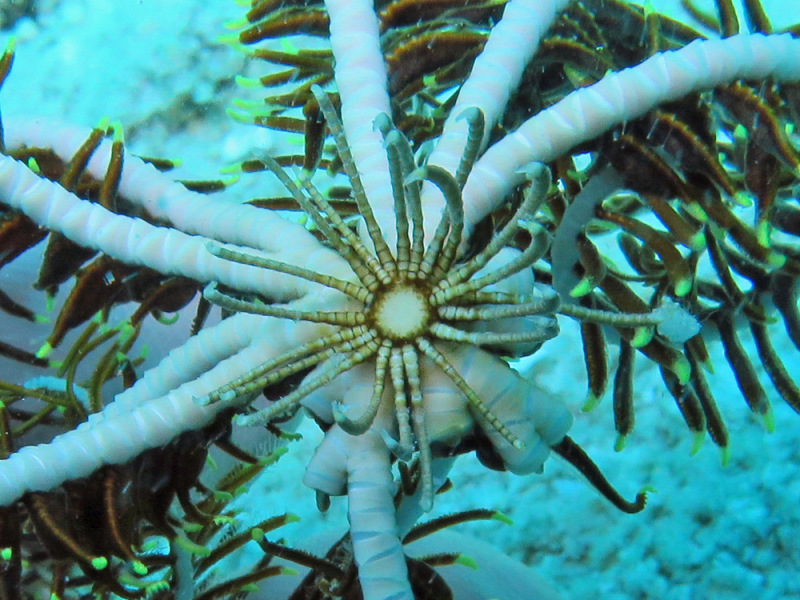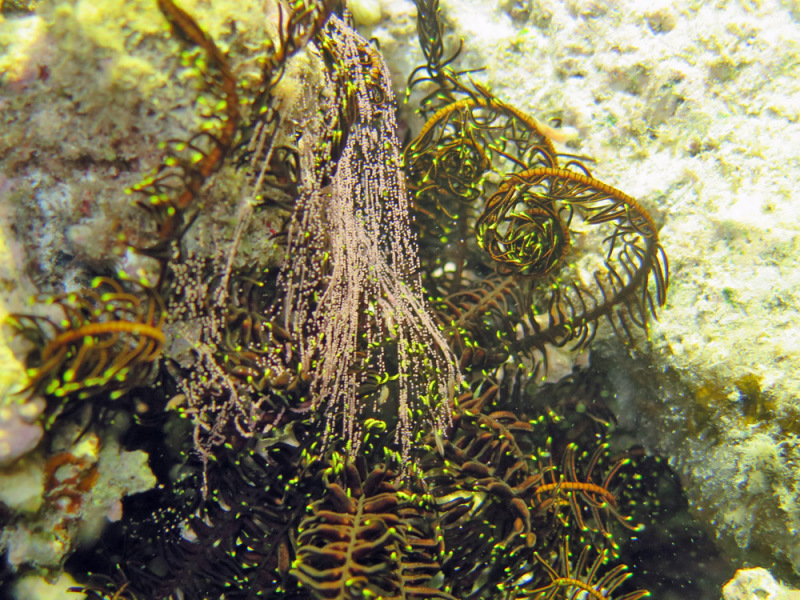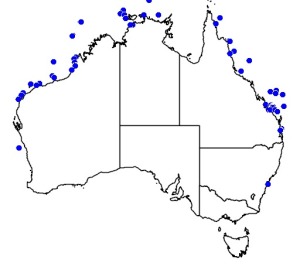
©Lyle Vail and Anne Hoggett: Comanthus wahlbergii at Lizard Island with arms exposed during the day.

©Anne Hoggett: Underside of Comanthus wahlbergii at North Direction Island, showing ring of cirri surrounding the central plate.
Colours
Distinguishing features
Comatulids are distinguised from all other featherstar families by having terminal segments of the oral pinnules modified to form a comb. Comatulids a also have a distinctive "feel" due to well developed hooks on most pinnules that cause them to cling like velcro.
Comanthus wahlbergii has up to 25 rather chunky arms, often longer on one side of the animal than the other, and a good ring of cirri.
Colour varies widely, both at Lizard Island and across its wide Indo-west Pacific distribution. At Lizard Island, the brachials are usually a solid colour including white, bright yellow, yellow/green, brown and a deep dusty blue, but occasionally a darker midline is present on the underside of the arms and the brachials may be covered with irridescent spots. Pinnules are often conspicuously different in colour to the brachials.
Size
- Size data has not been obtained.
Depth range
- Depth range data is not yet available.
Synonyms
Distribution
Distribution and habitat preferences
Comanthus wahlbergii is often completely concealed during the day, living within reef cavities or under large slabs of rubble, although several arms may be exposed. Arms are extended into the water column at night (Vail, 1987a) but the central body remains concealed.
This species is found throughout the Lizard Island Group but it is not often noticed because of its cryptic habitat.
Behaviour
A single female of this species was observed spawning in the Lizard Island lagoon at about 9.15 pm on 18 Nov 2016. Eggs emerged slowly from the genital pinnules in mucus strings (in contrast to the sudden burst of spawn observed once for Anneissia bennetti). Non-spawning specimens of Comanthus wahlbergii were also seen on the same dive.
Web resources
References
References that assist with identification
- Clark, A.M. and F.W.E. Rowe (1971). Monograph of shallow-water Indo-west Pacific echinoderms British Museum (Natural History), London.
- Rowe, F.W.E., A.K. Hoggett, R.A. Birtles and L.L. Vail (1986). Revision of some comasterid general from Australia (Echinodermata: Crinoidea), with descriptions of two new genera and nine new species, Zoological Journal of the Linnean Society, 86: 197-277. LIRS catalog number 198.
- Summers, M. M., C.G. Messing and G.W. Rouse (2014). Phylogeny of Comatulidae (Echinodermata: Crinoidea: Comatulida): A new classification and an assessment of morphological characters for crinoid taxonomy, Molecular Phylogenetics and Evolution, 80: 319-339. LIRS catalog number 1813.
- View all references






